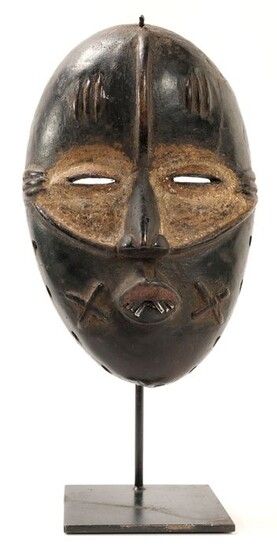Fine Dancemask - dense hardwood, cloth, metal - Weh-Bete - Ivory Coast
Fine Dancemask – Weh-Bete – Ivory Coast In good nick with sweet age patina in all parts, with a native repair above the left eye. It dates to the 1930s. Provenance: Ex – collection of the Rabier brothers, Brussels. Bought from their gallery by H. Westerdijk in 1988. This good old mask stems from the Weh – Bété group of people. The Weh (Wê) are in the older sources usually indicated as Gueré and or Wobé. Characteristic are the spared ridge on the central forehead and the ones that run between the nostrils toward the temples. Also raised or better still spared are the tattoo marks on the temples, forehead and cheeks. The bean – shaped eyes are set in a whitened zone. The tiny mouth has teeth made of iron set on the lower lip. Fine black patina from long use. The facial features of this mask are more Bété than Weh in character, which are normally a bit “wilder”. Literature: Warren M. Robbins and Nancy Ingram Nooter: African Art in American Collections, Washington-London, 1989, pp. 168-169. J. B. Bacquart, New York, 1998, pp. 44-45. Dimensions: 33x 15 x 9 cm People/ Region: The Weh- Bété live in S. W. ivory Coast and adjacent S. E. Liberia. Material: dense hardwood, cloth, metal. Weight: 0. 514 kg. Sold with handwritten declaration of authenticity by Dr. P. Westerdijk, museum ethnologist and cultural anthropologist specialized, for over 50 years now, in the study of the material cultures in African nations that live south of the Sahara.
[ translate ]View it on
Estimate
Time, Location
Auction House
Fine Dancemask – Weh-Bete – Ivory Coast In good nick with sweet age patina in all parts, with a native repair above the left eye. It dates to the 1930s. Provenance: Ex – collection of the Rabier brothers, Brussels. Bought from their gallery by H. Westerdijk in 1988. This good old mask stems from the Weh – Bété group of people. The Weh (Wê) are in the older sources usually indicated as Gueré and or Wobé. Characteristic are the spared ridge on the central forehead and the ones that run between the nostrils toward the temples. Also raised or better still spared are the tattoo marks on the temples, forehead and cheeks. The bean – shaped eyes are set in a whitened zone. The tiny mouth has teeth made of iron set on the lower lip. Fine black patina from long use. The facial features of this mask are more Bété than Weh in character, which are normally a bit “wilder”. Literature: Warren M. Robbins and Nancy Ingram Nooter: African Art in American Collections, Washington-London, 1989, pp. 168-169. J. B. Bacquart, New York, 1998, pp. 44-45. Dimensions: 33x 15 x 9 cm People/ Region: The Weh- Bété live in S. W. ivory Coast and adjacent S. E. Liberia. Material: dense hardwood, cloth, metal. Weight: 0. 514 kg. Sold with handwritten declaration of authenticity by Dr. P. Westerdijk, museum ethnologist and cultural anthropologist specialized, for over 50 years now, in the study of the material cultures in African nations that live south of the Sahara.
[ translate ]


